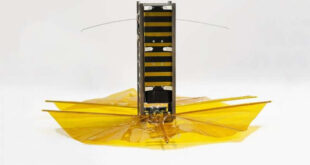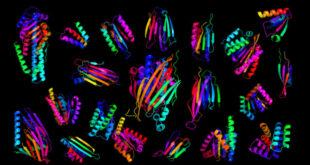An international team of researchers led by University of Wisconsin-Madison scientists has developed an easily implantable weight-loss device. In lab experiments, the device helped rats shed 38% of their body weight.
Operation principle of the vagus nerve stimulation (VNS) system schematically showing the pathway for biphasic electric signal generation and VNS. Image credit: Yao et al, doi: 10.1038/s41467-018-07764-z.
The weight-loss device is battery free, safe for use in the body and implantable via a minimally invasive procedure.
Measuring less than 0.4 inches (1 cm) across, it automatically generates gentle electric pulses from the stomach’s natural churning motions and delivers them to the vagus nerve, which links the brain and the stomach. That gentle stimulation dupes the brain into thinking that the stomach is full after only a few nibbles of food.
“The pulses correlate with the stomach’s motions, enhancing a natural response to help control food intake,” said University of Wisconsin-Madison’s Professor Xudong Wang, co-lead author of the study.
Unlike gastric bypass, which permanently alters the capacity of the stomach, the effects of the new device also are reversible.
When Professor Wang and co-authors removed the devices after 12 weeks, the study’s rats resumed their normal eating patterns and weight bounced right back on.
The new device has several advantages over an existing unit that stimulates the vagus nerve for weight loss.
That existing unit, Maestro, approved by the Food and Drug Administration in 2015, administers high-frequency zaps to the vagus nerve to shut down all communication between the brain and stomach. It requires a complicated control unit and bulky batteries which frequently must be recharged.
“That ongoing maintenance can be a big barrier to use,” University of Wisconsin-Madison’s Professor Luke Funk, who was not involved in the study.
“One potential advantage of the new device over existing vagus nerve stimulators is that it does not require external battery charging, which is a significant advantage when you consider the inconvenience that patients experience when having to charge a battery multiple times a week for an hour or so.”
In fact, the new device contains no batteries, no electronics, and no complicated wiring. It relies instead on the undulations of the stomach walls to power its internal generators. That means the device only stimulates the vagus nerve when the stomach moves.
“It’s automatically responsive to our body function, producing stimulation when needed. Our body knows best,” Professor Wang said.
The team’s work appears in the journal Nature Communications.
_____
Guang Yao et al. 2018. Effective weight control via an implanted self-powered vagus nerve stimulation device. Nature Communications 9, article number: 5349; doi: 10.1038/s41467-018-07764-z
 #Bizwhiznetwork.com Innovation ΛI |Technology News
#Bizwhiznetwork.com Innovation ΛI |Technology News




